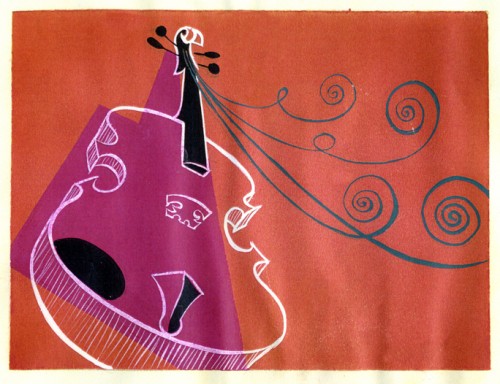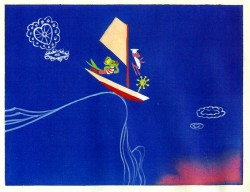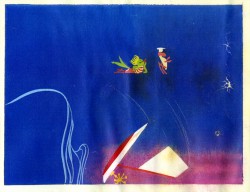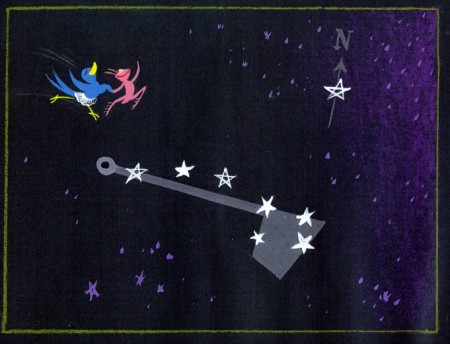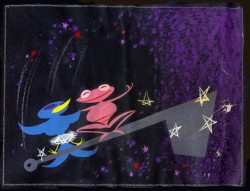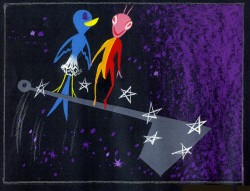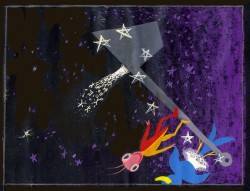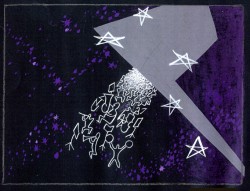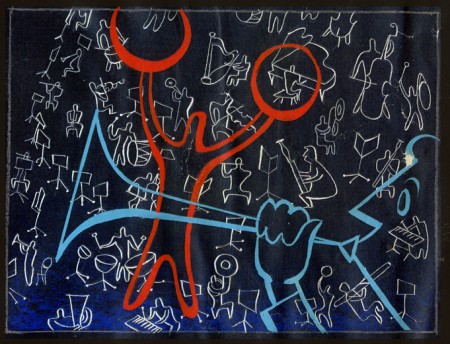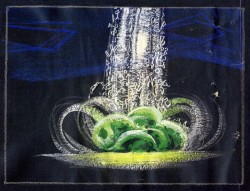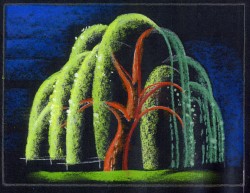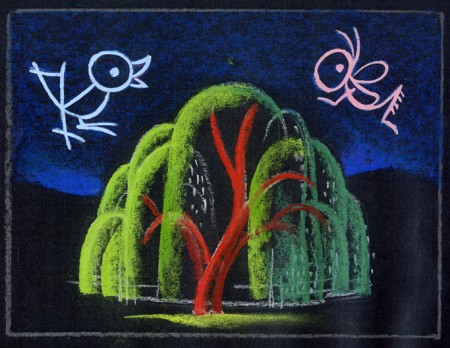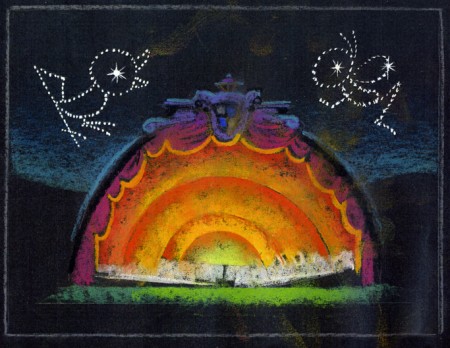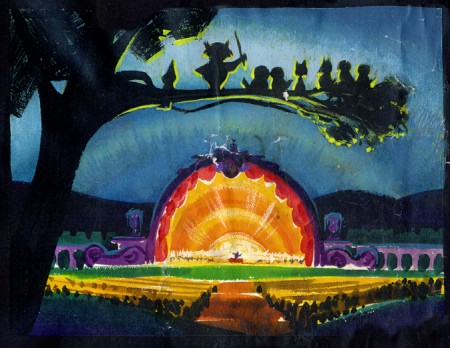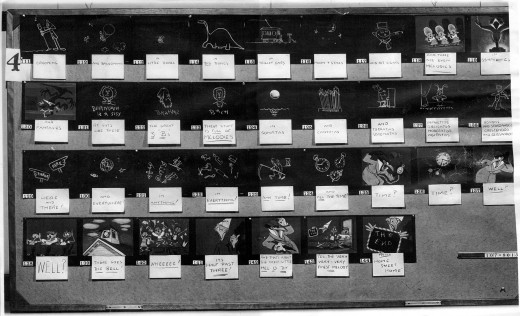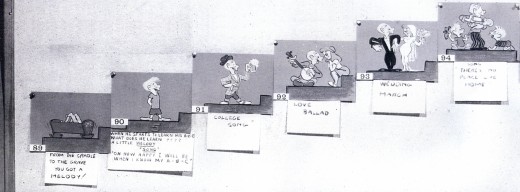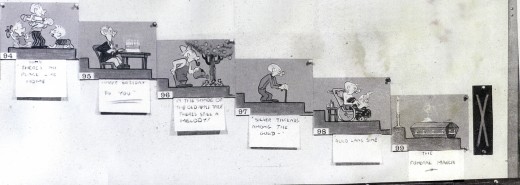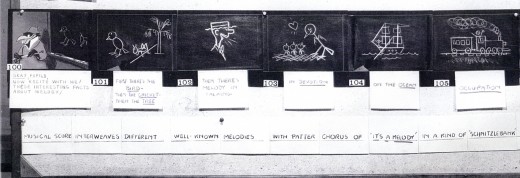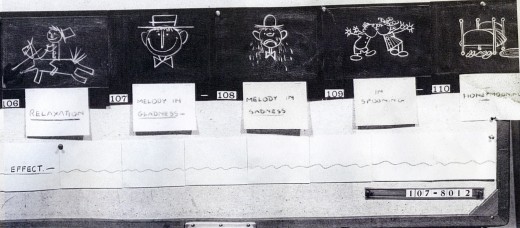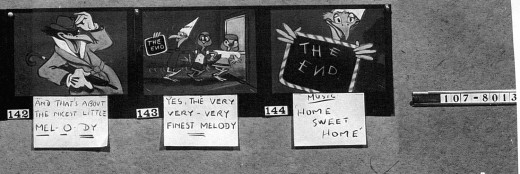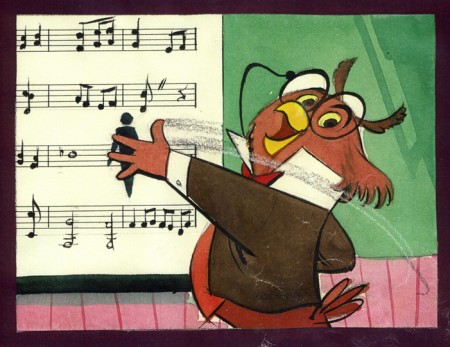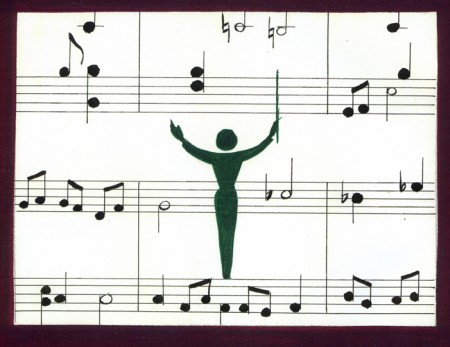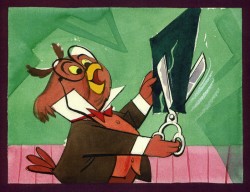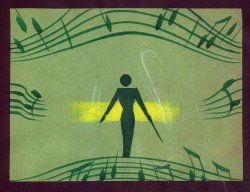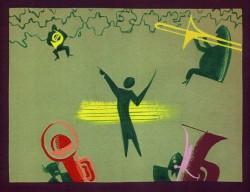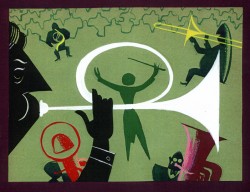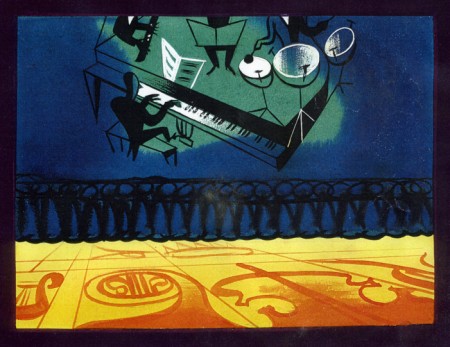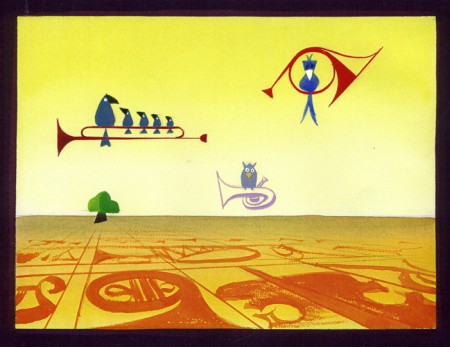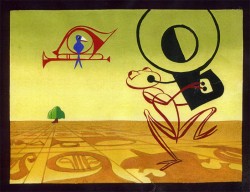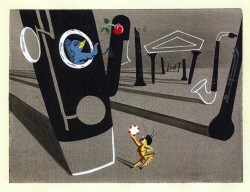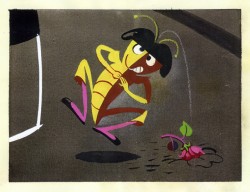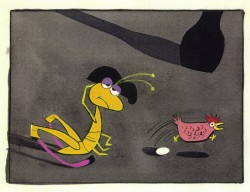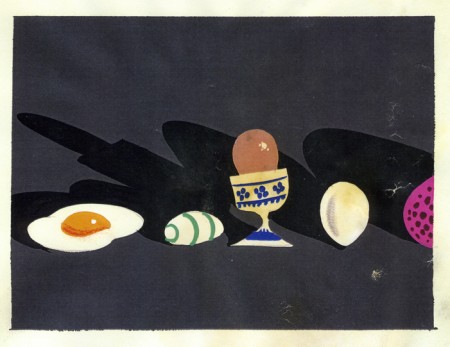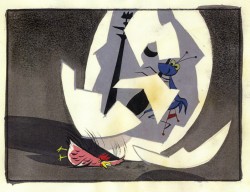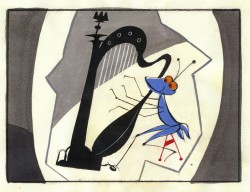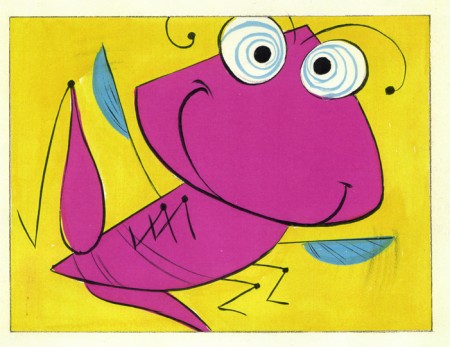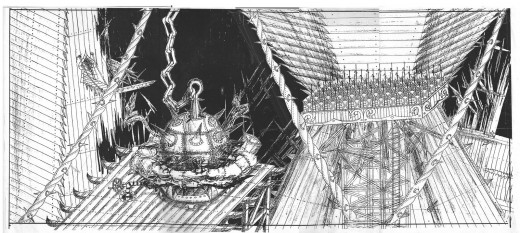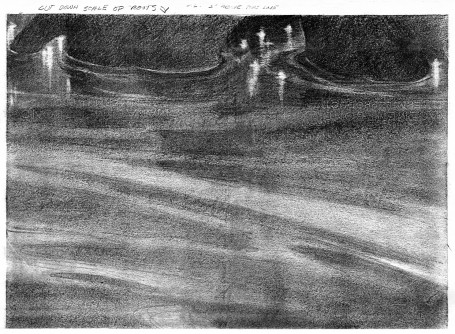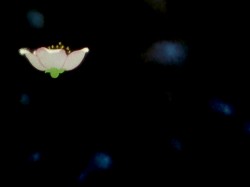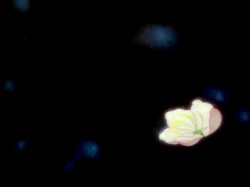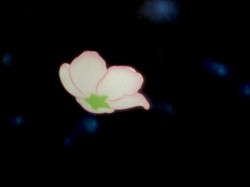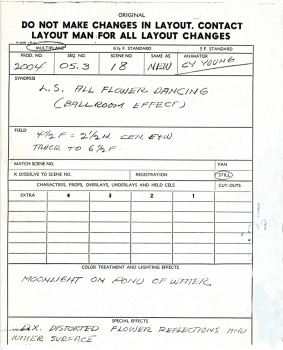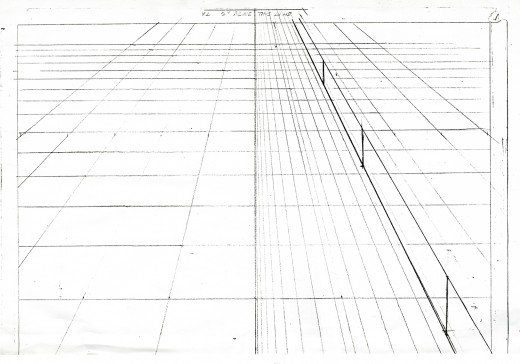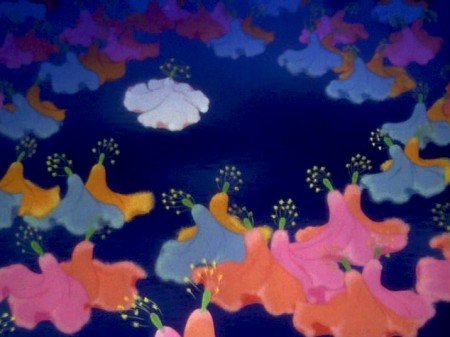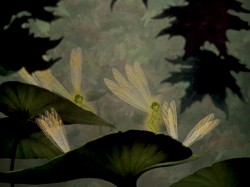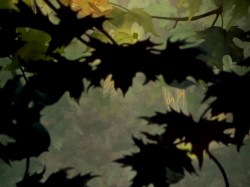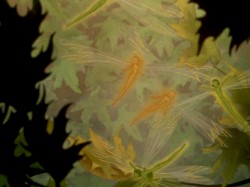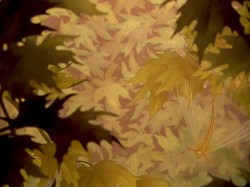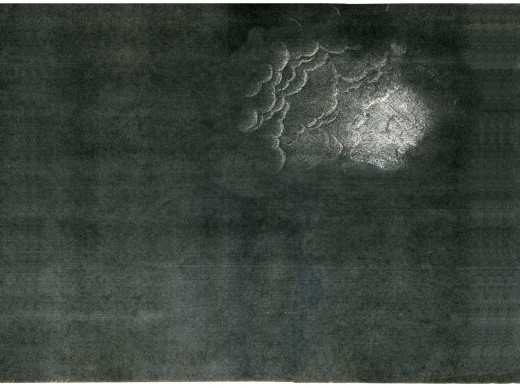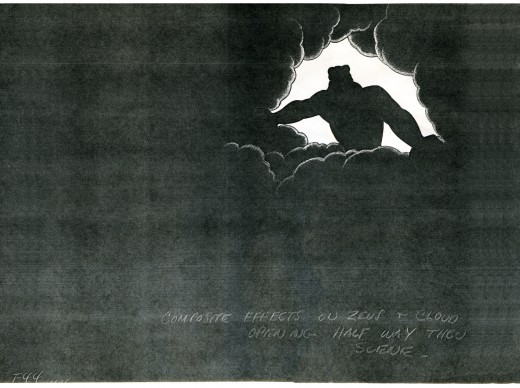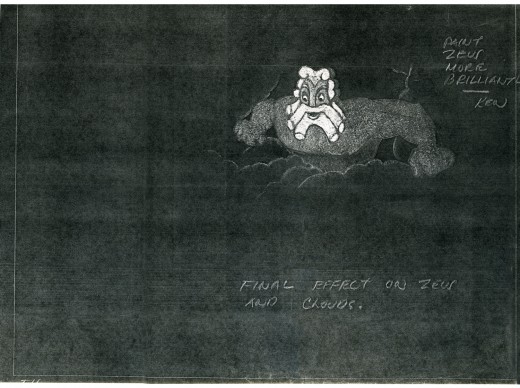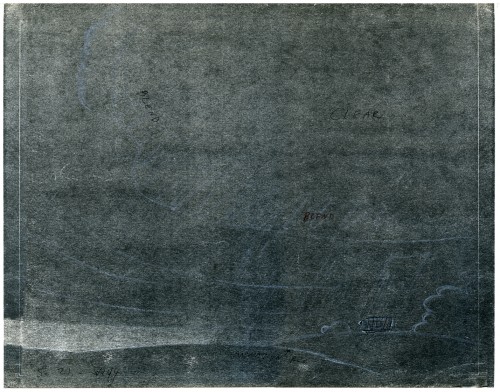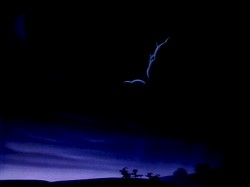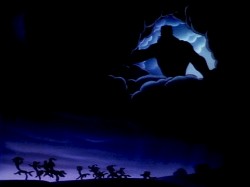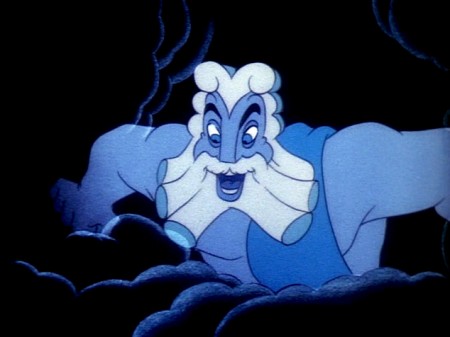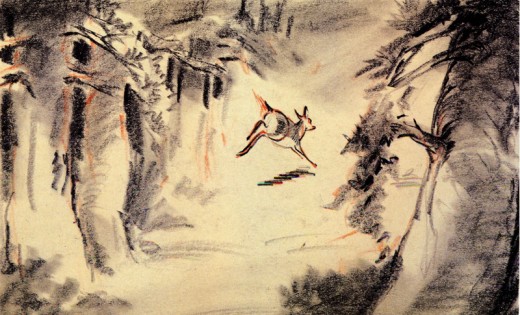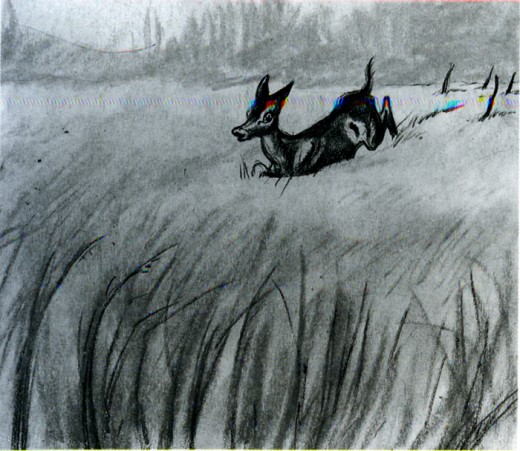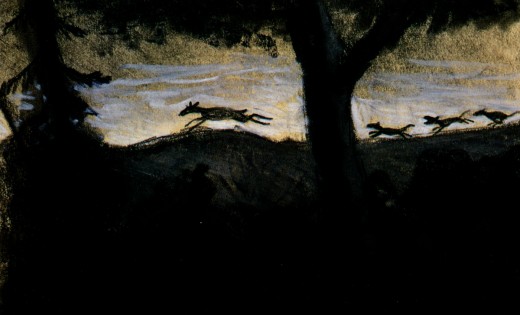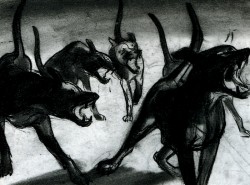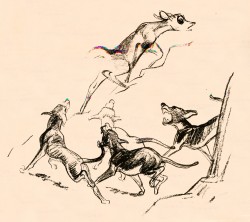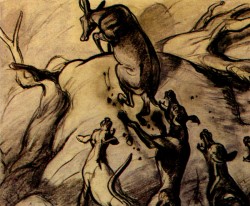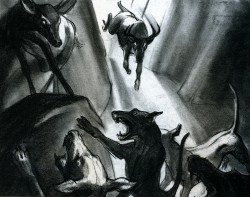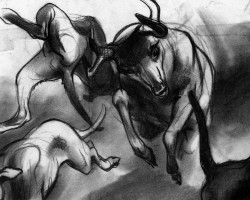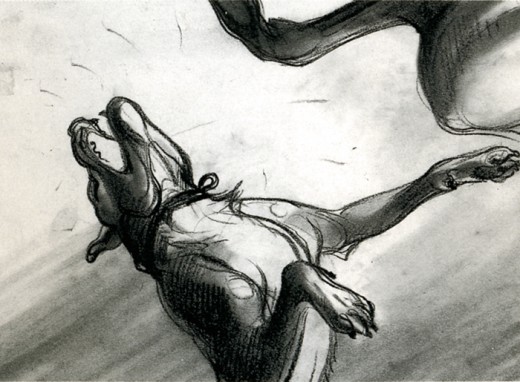Search ResultsFor "fantasia"
Animation Artifacts &Disney &Story & Storyboards 10 Oct 2008 08:17 am
Melody Art – 2
- Having completed posting the first storyboard to the Disney short, Melody: Adventures In Music I’d like to complete my posting of the preliminary art and boards for this film. I’d displayed the first half of this artwork last week.
Needless to say, John Canemaker has to be thanked many times over for lending me this rare material from his collection.
When the images have pegs on them (the black ones), I’ve given a complete scan in the enlarged version.
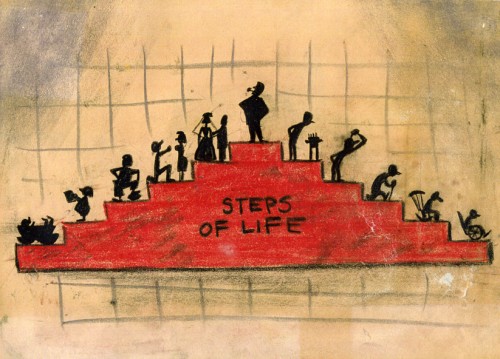
(Click any image to enlarge.)
Let me also repeat the following information. You can find frame grabs from this short on Ward Jenkins‘ site, The Ward-O-Matic.
MELODY is included in the Walt Disney Treasures: Disney Rarities dvd set and it is also found in the bonus features of the Fantasia 2000 dvd.
The film is also on YouTube (at the moment) in not the best condition.
Animation Artifacts &Disney &Story & Storyboards 06 Oct 2008 08:12 am
Melody Board 1 – pt.2
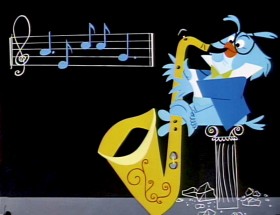 - Last week I posted the first part of the storyboard to the Disney short, Melody: Adventures in Music. This is another gem loaned to me by John Canemaker. It’s the first board to this short and has only some resemblance to the actual film.
- Last week I posted the first part of the storyboard to the Disney short, Melody: Adventures in Music. This is another gem loaned to me by John Canemaker. It’s the first board to this short and has only some resemblance to the actual film.
Next week, I’ll post a second board for the same film, one that looks very different and more like the final cartoon.
I’ve also posted some of the artist sketches for the film and will have more of those later this week.
Here are the last two storyboard panels in full size:
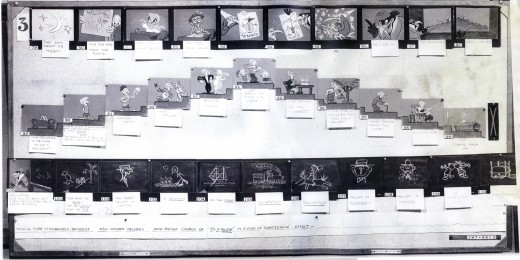
(Click any image to enlarge.)
Here are the rows of this board broken into halves so that I can get you the largest possible images:
You can find frame grabs from this short on Ward Jenkins‘ site, The Ward-O-Matic.
MELODY is included in the Walt Disney Treasures: Disney Rarities dvd set and it is also found in the bonus features of the Fantasia 2000 dvd.
Animation Artifacts &Disney &Layout & Design &Story & Storyboards 02 Oct 2008 07:38 am
Melody Art
- When posting the storyboards from Melody: Adventures In Music, that were loaned me by John Canemaker, last Monday I mentioned that John had also offered some artwork from the film – color keys and story sketches. I’ll post these in two parts: the first here, the second next week after completing the board.
Unfortunately, I don’t know who the artists were that painted these.
Eyvind Earle is credited as Color Stylist; Ken O’Connor and Victor Haboush were credited for Art Direction.
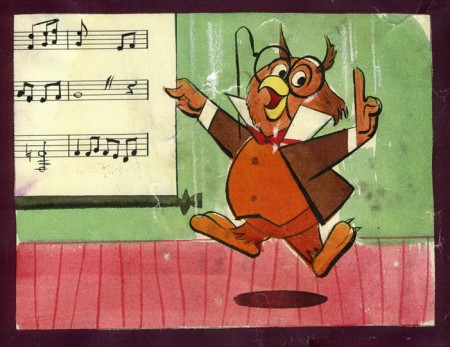
(Click any image to enlarge.)
To be concluded next week.
.
You can find frame grabs from this short on Ward Jenkins‘ site, The Ward-O-Matic.
MELODY is included in the Walt Disney Treasures: Disney Rarities dvd set and it is also found in the bonus features of the Fantasia 2000 dvd.
The film is also on YouTube (at the moment) in not the best condition.
Daily post &Richard Williams 15 Sep 2008 08:11 am
Up and Coming to NY
I received the following press release from MOMA re their program to be held next Monday. I’ve been told that this will be a different show from the one being conducted in Ottawa.
- MASTER CLASS:
RICHARD WILLIAMS IN CONVERSATION WITH JOHN CANEMAKER
Monday, September 22
7:00 p.m.
The Roy and Niuta Titus 2 Theater
Three-time Academy Award winner Richard Williams discusses his long and influential career in a conversation with animation filmmaker and historian (and fellow Oscar-winner) John Canemaker.
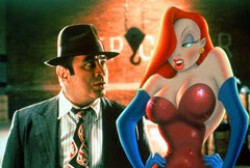 Williams, who was awarded Oscars for Special Achievement and for Visual Effects as the director of animation of the Walt Disney/Steven Spielberg blockbuster Who Framed Roger Rabbit (1988) and for his short film A Christmas Carol (1971), is one of the finest animation filmmakers of our time.
Williams, who was awarded Oscars for Special Achievement and for Visual Effects as the director of animation of the Walt Disney/Steven Spielberg blockbuster Who Framed Roger Rabbit (1988) and for his short film A Christmas Carol (1971), is one of the finest animation filmmakers of our time.
His stunningly crafted, award-winning films have featured the work of veteran animators from the Disney studio’s “Golden Age” and from Warner Bros. Cartoons, most notably Grim Natwick (Snow White), Art Babbitt (Fantasia), and Ken Harris (Bugs Bunny). Williams also learned from his friends Milt Kahl (Pinocchio, The Jungle Book), and Frank Thomas (Bambi, Cinderella).
A distillation of his acquired knowledge went into the exuberant animation he directed for Who Framed Roger Rabbit and, most recently, into an unparalleled and indispensable series of instructional DVD master classes based on his bestselling book The Animator’s Survival Kit.
Illustrated with clips from Who Framed Roger Rabbit, The Charge of the Light Brigade, A Christmas Carol, Raggedy Ann & Andy, the animated titles from The Return of the Pink Panther, award-winning commercials, segments from The Animator’s Survival Kit, and more.
Organized by Joshua Siegel, Asst. Curator, Department of Film, and John Canemaker.
Then on Tuesday ASIFA East will hold this program:
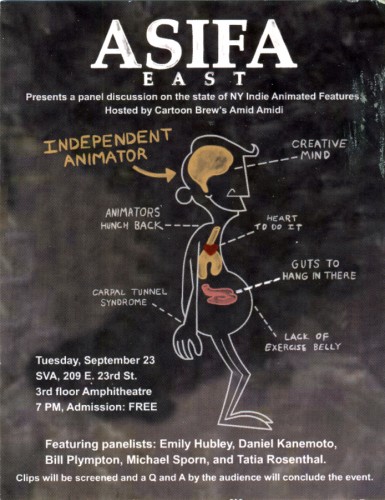
- ASIFA- East
A panel discussion on the state of NY Independent Animated Features.
Hosted by Cartoon Brew’s Amid Amidi and featuring paneiists:
Emily Hubley, Daniel Kanemoto, Bill Plympton, Michael Sporn, and Tatia Rosenthal.
Clips wif! be screened and a Q and A by the audience will conclude the event,
Tuesday, September 23
SVA, 209 E. 23rd St.
3rd floor Amphitheatre
7 PM, Admission: FREE
Check out our web site for the latest news at www.asifaeast.corn
Animation Artifacts &Commentary &Hubley 01 Aug 2008 08:05 am
Everybody Rides – 2
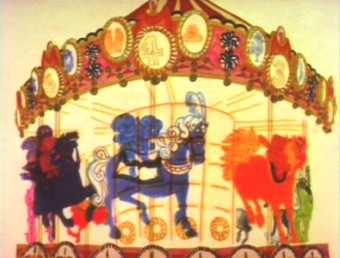 – We started slowly on Everybody Rides the Carousel. There was a six month schedule for about 72 mins of animation. Three half-hour original tv shows for CBS about 24 mins each. They’d air in the late summer of 1975 just prior to the start of the new tv season. Each show would air a day apart from the others – three nights in a row.
– We started slowly on Everybody Rides the Carousel. There was a six month schedule for about 72 mins of animation. Three half-hour original tv shows for CBS about 24 mins each. They’d air in the late summer of 1975 just prior to the start of the new tv season. Each show would air a day apart from the others – three nights in a row.
John and Faith spent a lot of time – a lot of time – at RCA studios on 45th Street. (It’s
____ The carousel was bottom lit & became soft focus.____-_ now an IRS office.) They recorded many of voices playing the numerous parts in their show. I tried to time meeting them there a couple of times hoping to meet some of the actors (I particularly wanted to see Jack Gilford in action. He was doing an hilarious part with his wife, playing a couple of cranky old people in a diner.) It didn’t work out that way, but I did see the facility and heard parts in process.
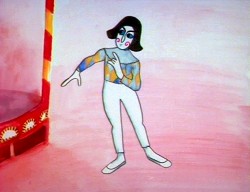 The key staff working IN the studio (not counting animators who would, for the most part, work freelance) included Ida Greenberg. Ida was a brilliant checker/coordinator who’d started back in the Florida days of the Fleischer studio. (She told me a few great stories about Gulliver’s Travels.) Ida was a great woman, with the thickest New Yowk accent, who never seemed to buckle under pressure. I grew very close to her. I tried after that to have Ida everywhere I worked. She led Raggedy Ann’s I&Pt and R.O.Blechman’s special._____________ Art Babbitt animated some of the mimes.
The key staff working IN the studio (not counting animators who would, for the most part, work freelance) included Ida Greenberg. Ida was a brilliant checker/coordinator who’d started back in the Florida days of the Fleischer studio. (She told me a few great stories about Gulliver’s Travels.) Ida was a great woman, with the thickest New Yowk accent, who never seemed to buckle under pressure. I grew very close to her. I tried after that to have Ida everywhere I worked. She led Raggedy Ann’s I&Pt and R.O.Blechman’s special._____________ Art Babbitt animated some of the mimes.
Kate Wodell was a student of the Hubleys at Yale. She was a talented artist who’d moved into production during the making of Cockaboody and continued on staff there. Sometimes she colored, sometimes she animated, sometimes she did whatever was necessary. This was exactly how I moved into the studio and loved the experience. She worked with Faith for many years after John died.
Earl James was an animator who’d worked in the backroom of many NY studios from Paramount to Terrytoons to NY Institute of Technology. He also had done some comic strip work.
Earl was given the carousel to animate. This came from a couple of elaborate drawings John did. Earl worked 16 fld. using a 96 drawing cycle. It gave us a lot of opportunity to move in tight or stay wide. However, it was a nightmare that took forever. Joe Gray was hired to assist Earl. (Joe started during the Terrytoons strike and never left. He was a lifetime assistant like a handful of other noted names in NY.)
This scene moved so slowly through production that I kept jumping in to assist as well. I was a fast assistant, but that carousel slowed even me down. 8 horses moved in perspective in a circle; you got to see 96 different rotating views of all the horses. I’d guess the scene took about 10 weeks to complete.
I was also doing layout and animation of a lot of connecting scenes throughout the production. These were scenes that would have to blend from one animator to another, or John had decided to go in tight for a closeup. In one case with Art Babbitt’s mime character, I was asked to change it from two’s to four’s with a dissolve technique John taught me (he said they’d used it on Fantasia.)
There were four people in my room, Earl, Joe, me and Mark Hubley. He worked alongside me for most of the film. He colored artwork given him by Ida, who was working in the larger room next door. Mark and I had a good releationship going back the many years I worked there. He joined the studio once he completed college. Emily Hubley worked alongside Kate and Ida.
Two younger, more experimental animators were brought in by John. Adam Beckett had made a name for himself with the films he was doing at CalArts.
Fred Burns was doing some incredible work at UCLA. They both were very different and added their unique touch.

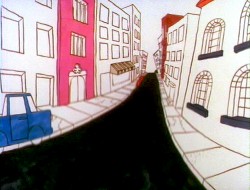
___________ Adam Beckett’s scenes included these two surreal images.
Adam did a scene a couple of scenes wherein office furniture floated about in a very complicated surreal cycle. Fred did this amazing scene of a roller coaster from the POV of the rider. He and I worked together a number of times after that, and we’ve stayed friends.
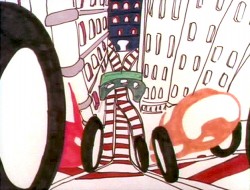
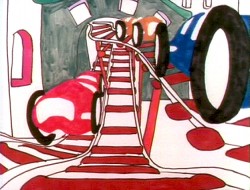
______________ Fred did this very elaborate sexual roller coaster.
I decided, last week, that I had a lot to say about this feature film. Hence, you’ll have to excuse me for reminiscing over the series of pieces I’m going to write. I also have some artwork – other than frame grabs – that I’ll try to share in future pieces.
Commentary 06 Jul 2008 08:13 am
more or less – 2
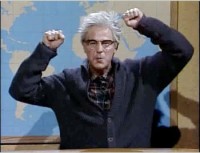 - Dana Carvey, on Saturday Night Live, used to have the “grumpy old man” character. “We had to eat worms, and we liked it!” I’m beginning to feel like the grumpy old man, but I’m hoping I’m saying something here, that touches a nerve in someone else.
- Dana Carvey, on Saturday Night Live, used to have the “grumpy old man” character. “We had to eat worms, and we liked it!” I’m beginning to feel like the grumpy old man, but I’m hoping I’m saying something here, that touches a nerve in someone else.
Yesterday, I was headed in the direction of saying that computer animation in Harry Potter or Lord of the Rings or Indiana Jones 4 was no different to me than the computer animation in Wall-E or, ultimately, Kung Fu Panda. They all move, but, to me, none of them live. The “animus” isn’t there. Artful, well crafted movement is there, but it’s not something that inspires me to go out and draw or get back to my animation box (for the most part, a computer.)
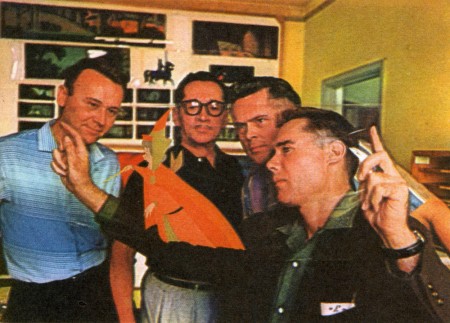 I can remember when just looking at the picture to the right of Eyvind Earle holding up a Sleeping Beauty cel (in Bob Thomas’ book, The Art of Animation) would thrill me to the bone so that I had to start drawing or get myself to the board.
I can remember when just looking at the picture to the right of Eyvind Earle holding up a Sleeping Beauty cel (in Bob Thomas’ book, The Art of Animation) would thrill me to the bone so that I had to start drawing or get myself to the board.
After the release of Beauty and the Beast, John Canemaker and I had a conversation. He pointed out that once he or I would have been taken by a screening of Fantasia or Dumbo and been inspired to animate, and a youngster, today, seeing B and the B would have that same rush. The newer film may not have inspired either of us, but other, younger, future animators were. This was comforting to me.
But recently, when commenting about Wall-E, I wondered if anyone would be inspired by that film. Were there youngsters out there who felt compelled to animate after seeing the Pixar movie? Perhaps through lack of imagination, I can’t see it. But I can’t see it.
Somehow, though, The Iron Giant seemed like something that could inspire people. I also thought The Triplettes of Belleville and Persepolis were inspirational to future animators. I expect the same was true of Toy Story, The Incredibles, even Ratatouille. Perhaps even Kung Fu Panda.
When Don Bluth ran away from Disney and set up his own company to make The Secret of Nimh, there was a lot of excitement in watching their progress. The film wasn’t all we hoped for, but it was light years better than The Black Cauldron.
When Katzenberg left Disney and set up Dreamworks, there was a charge generated, and it was exciting waiting for Prince of Egypt. The film was pretty good, too, and seemed to auger good things for the future of Dreamworks. The announcement of William Steig’s Shrek was a real charge. The horribly ugly film that was produced was so much the loss for computer animation, and that’s when everything changed. Yeah, the grass moved ok, but it was near impossible looking at the damned thing. A sarcastic, sardonic story led the way for nasty films to come. Attitude became everything, and the graphics were lousy.
Animation seems to be diving deep and hard.
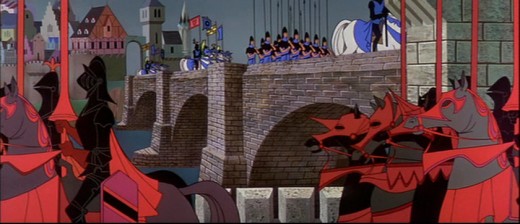
I don’t think it gets more artful than this.
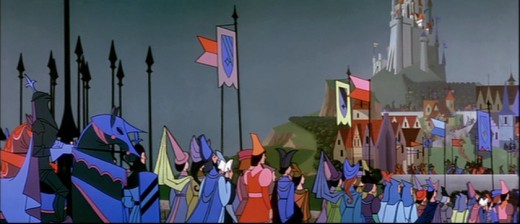
So what’s the answer? We’re in a hole; how do we get out?
It’s all about hope and hard work and not giving up finding that inspiration wherever you can.
A couple of years ago, I was about to throw in the towel. As usual, it was an incessant fight to keep my tiny company afloat. Just paying the rent was sapping my soul from any animation I could pick up. I wasn’t inspired by any of the films I was seeing, and I was beginning to lose hope.
Mike Barrier‘s book, Hollywood Cartoons, arrived just when I needed it, and I soaked it in. The book – especially the writing on Snow White – just charged me like no tomorrow. I finished reading it and started reading it again, immediately. That book saved me, no doubt, and I couldn’t have been more charged. Things turned around for me just by being excited by my medium.
You have to find the book or the film or the charge that’s going to keep you going. Writing this blog helps me, these days. In doing it, I’m always looking into films and frame grabs and endlessly studying animation I love. I can look past films that I think hurt the medium and find something that I love.
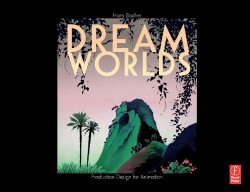 So many books such as Hans Bacher‘s Dream Worlds or Amid Amidi‘s Cartoon Modern offers lots of art; you have to find some inspiration. I’m looking forward to Sylvain Chomet‘s next film, The Illusionist. I want to see Clint Eastwood’s new film, The Changeling. Of course, I can always go to a museum in New York to find art that excites me. And live theater sometimes excites me.
So many books such as Hans Bacher‘s Dream Worlds or Amid Amidi‘s Cartoon Modern offers lots of art; you have to find some inspiration. I’m looking forward to Sylvain Chomet‘s next film, The Illusionist. I want to see Clint Eastwood’s new film, The Changeling. Of course, I can always go to a museum in New York to find art that excites me. And live theater sometimes excites me.
In short there are worlds out there, and I find it up to me to get that inspiration moving. I’ll probably focus on more of those books and films and artworks that inspire me, so this rant just ain’t going to end any time soon.
Sorry.
Animation Artifacts &Daily post 26 May 2008 09:40 am
More Notes
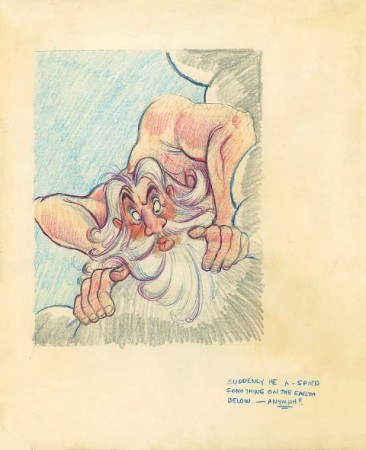 - After all the artwork from Fantasia that I posted in the past week or so, I received an email from Howard Penner. He had a beautiful sketch of Zeus looking down from the clouds.
- After all the artwork from Fantasia that I posted in the past week or so, I received an email from Howard Penner. He had a beautiful sketch of Zeus looking down from the clouds.
Howard wondered whether it could have been drawn by James Bodrero, who did other storyboard sketches in a series I posted on loan from John Canemaker.
It looked somewhat different in style to me, so I asked John. He wasn’t able to affirm that it was Bodrero’s work, though he suggested it also might be by Martin Provenson or Jack Miller, both of whom also worked on this same sequence. It has more the cartoony look that I would expect from a Provenson drawing, so that’s where I’m siding. Any other guesses?
Here are some closer scans:
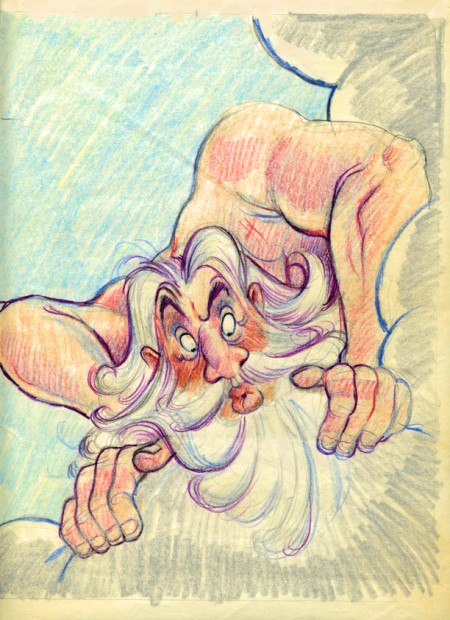
(Click any image to enlarge.)
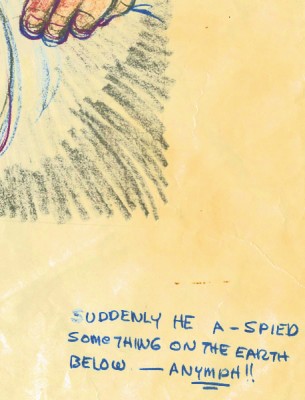
Having written “A-Spied” shouldn’t
he have written “A-Nymph”?
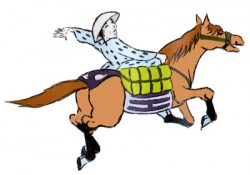 - Ken Priebe has written me to inform about the Vancouver Art Gallery’s program called Krazy!. It’s a show of original sketches, notes, concept drawings, animation cells, and 3-D models.
- Ken Priebe has written me to inform about the Vancouver Art Gallery’s program called Krazy!. It’s a show of original sketches, notes, concept drawings, animation cells, and 3-D models.
Ken writes in depth about it on his blog The Boundaries of Fantasia.
Ken also informed me that the brilliant animator, Tony White, has just posted a number of his films and reels on YouTube. Go here to see all of these short films. Don’t miss Hokusai; it’s a great film which won the BAFTA in 1978. Tony’s commercial work can be seen here.
Ken Priebe is the author of The Art of Stop-Motion Animation.
Tony White has written Animation from Pencils to Pixels and the classic book The Animator’s Workbook.
- Sony Classic Pictures bought the distribution rights of Waltz with Bashir before the Cannes Festival closed yesterday. This assures that the film will eventually be released in the US. The film did not win any awards at the Festival as was predicted by a couple of reporters. Juror Natalie Portman commented on this, “I think it’s a testament to the amazing selection (in the Festival) that a film as good as ‘Waltz With Bashir’ didn’t win an award.”
Daily post &Music 23 May 2008 08:31 am
Notes
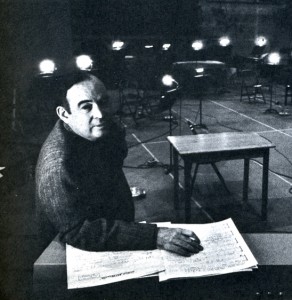 - This week, I enjoyed posting the article by Ross Care on the music of Bambi.
- This week, I enjoyed posting the article by Ross Care on the music of Bambi.
I have been a film music fan almost as long as I have been an animation enthusiast. When I was 12, I bought my first soundtrack, the score to To Kill A Mockingbird, by Elmer Bernstein. What a way to start! This was almosts immediately followed by Lillies of the Field by Jerry Goldsmith. I subsequently bought every score I could find by either of them and stayed a devotee of both. (Animation fans might recognize Goldsmith’s brilliant score for The Secret of Nimh and Mulan or Bernstein’s for The Black Cauldron and Heavy Metal.)
______Ed Plumb in a break between
______recording sessions on Fantasia.___________I have spent quite a bit of interest
__________________________.________________searching down any bits and pieces of information written about film scores and film musicians. I virtually absorbed Roy Pendergast‘s book, Film Music: A Neglected Art, with its interview with Scott Bradley and discussion wiht Gail Kubik (who wrote the score to Gerald McBoing Boing.) I subscribed to Film Score Monthly and Soundtrack Collector’s Newsletter, and I belonged to collector’s groups that would introduce Japanese versions of many scores that included cues that weren’t included in US releases or offered records that weren’t available here. In short, I was obsessed.
That obsession has quieted somewhat, though I still pay close attention to soundtracks and scores. Goldsmith and Bernstein are gone now, but there’s still Tom Newman and James Horner and John Debney (who did the score for my film, Goodnight Moon.)
Ross Care, who wrote the article on Bambi and has written and performed much of his own music – concert as well as filmusic – wrote to tell me that he has a concert upcoming in LA.
Letter to the World – Poets to Song,
Original Songs by Ross Care
June 8, 2008 2pm
First United Methodist Church
1338 E. Santa Clara St.
Downtown Ventura
805-901-2697
Suggested Donation, $15
Featuring the poems of Lewis Carroll, Edward Lear, Christina Rossetti, Frank O’Hara, Emily Dickinson, James Joyce, William Blake and A.E. Housman
Ross Care, Composer/Pianist
Diana Burdick, Soprano
Molly Kohler Pei, Soprano
Steve Perren, Baritone
Philip Vaiman, Violin
Maksim Velichkin, Cello
- Notes on the Music
Care has always been interested in the fusion of music and poetry in a somewhat
neglected form, the modern art song. “Letter To The World†draws from both classic
and modern texts. The settings in this concert are written for voice and piano and
voices with piano, violin, and cello.

- Nina Paley is interviewed in depth on Film & Video‘s site. The subject is how she animated a feature length film, Sita Sings The Blues, in Flash. The film just recently finished playing in the Tribeca Film Festival and will soon show at Annecy.
You can read Variety‘s very positive review here.
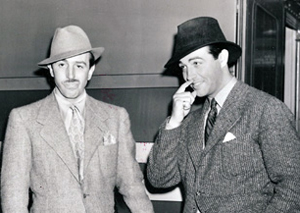 - I enjoy Mike Barrier‘s essays built around “A Day In The Life” of someone or some animation studio.
- I enjoy Mike Barrier‘s essays built around “A Day In The Life” of someone or some animation studio.
These are extraordinary little commentaries on moments in time. His most recent details a trip Walt and Lillian Disney made to New York in 1938 where they met a young Robert Taylor on the train.
Disney: June 20, 1938
These pieces really give you a feel for the time and place of the event. This is something too often left out of animation history and an aspect that I demand of good history (even if I have to supply it myself.)
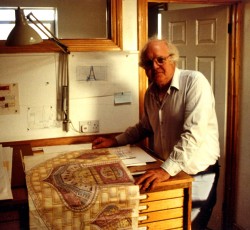
- The fine blog, The Thief, has two excellent pieces on Roy Naisbitt. Roy was one of the keys to the Richard Williams Studio. The two posts feature some of the elaborate and exceptional art Roy did for Dick’s feature, The Cobbler and the Thief. Roy was probably the closest thing Dick had to a computer back in the ’70′s. The post calls him a “certified genius,” and I’d have to agree. For years I knew about Roy’s work; The Thief gives us some of his drawings.
There’s some amazing art here.
Roy Naisbitt pt 1
Roy Naisbitt pt 2
Animation &Animation Artifacts &Disney &Layout & Design 19 May 2008 08:44 am
A Couple of Fantasia Layouts
- I have a few really down and dirty older xeroxed copies of layouts for some Fantasia scenes. Without defining what they are, I thought I’d just post them and let you figure them out. When I have the folder info, I post that as well so you can see who did what.
I follow the LO’s of each scene with frame grabs from that scene.
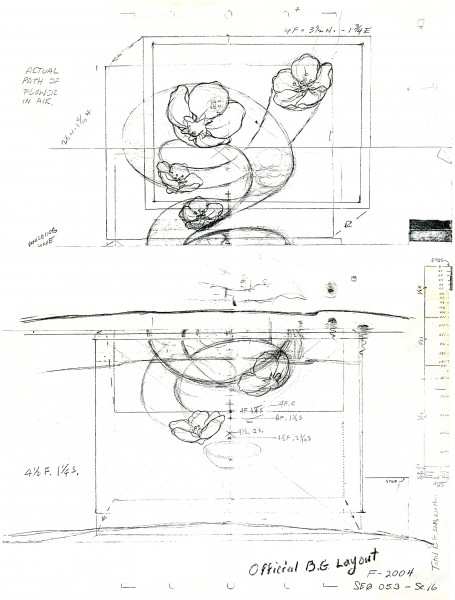
___Falling flowers land on water. Unfortunately, a small part of the
midsection for this drawing is missing. The xeroxes, of course,
are all large and reconstructing them was a bit complex.
The BG layout is below.
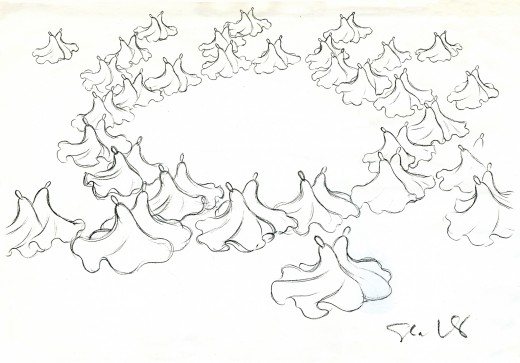
These two drawings represent twirling blossoms as well as
the perspective planning for them and the background for the scene.
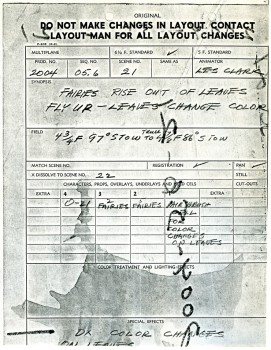
The following two long pans show a background of leaves and the
progression of Faeries that sparkle around those leaves.
Animation &Animation Artifacts &Books &Disney &Story & Storyboards 13 May 2008 08:12 am
Retta’s Dogs
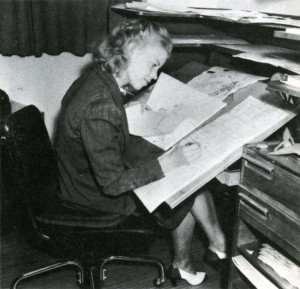 – Retta Scott has been fascinating to me from the earliest days in my interest in animation. I believe it was on a “Disneyland” when I first heard her name. Back then the research readily available to me was not great. Bob Thomas’ book The Art of Animation listed her as an animator on Bambi. It doesn’t even give her credit for Fantasia, despite her principal work on the Pastoral sequence. Nor does it mention her work on Dumbo, The Wind In the Willows or The Ruluctant Dragon.
– Retta Scott has been fascinating to me from the earliest days in my interest in animation. I believe it was on a “Disneyland” when I first heard her name. Back then the research readily available to me was not great. Bob Thomas’ book The Art of Animation listed her as an animator on Bambi. It doesn’t even give her credit for Fantasia, despite her principal work on the Pastoral sequence. Nor does it mention her work on Dumbo, The Wind In the Willows or The Ruluctant Dragon.
She was layed off at Disney’s when they hit a slump in 1941 but came back to do a number of Little Golden Books for Disney. The most famous of her books was her version of Cinderella, one which was so successful that it remains in print today as a Little Golden Book. She was an animator on Plague Dogs.
When asked why females weren’t animators at the studio, the Nine Old Men who traveled the circuit, back in the 1970′s, often mentioned her. They usually also said that she was one of the most forceful artists at the studio, but her timing always needed some help (meaning from a man.)
Ms. Scott was known predominantly for her animation in Bambi. Specifically, she’s credited with the sequence where the hunter’s dogs chase Faline to the cliff wall and Bambi is forced to fight them off. The scene is beautifully staged and, indeed, is forceful in its violent, yet smooth, movement.
Ms. Scott died in 1990.
Continuing with prior posts featuring some of the sketch work from this film, I feature some of the original work from this sequence. Many of these drawings are storyboard pieces and are not actually the work of Ms. Scott. However, they certainly inspired what she would animate.
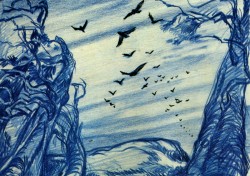 __
__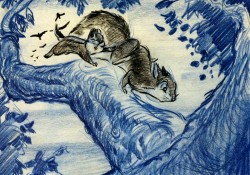
___________________(Click any image to enlarge.)
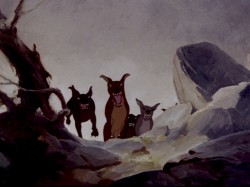
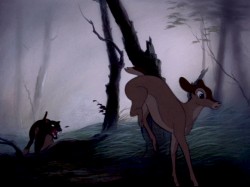
_________These, above, are two frame grabs from the sequence.
__
The dogs corner and chase Faline up a rock wall where she tries to stave off the violence of the attacking dogs. She remains there until Bambi comes to save her, fighting off the dogs.
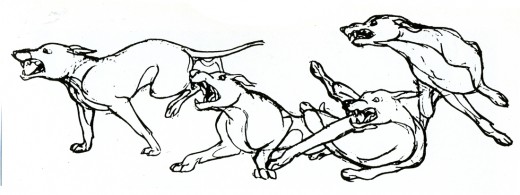
_____Though most of the drawings above aren’t the work of Retta Scott, this one is.
